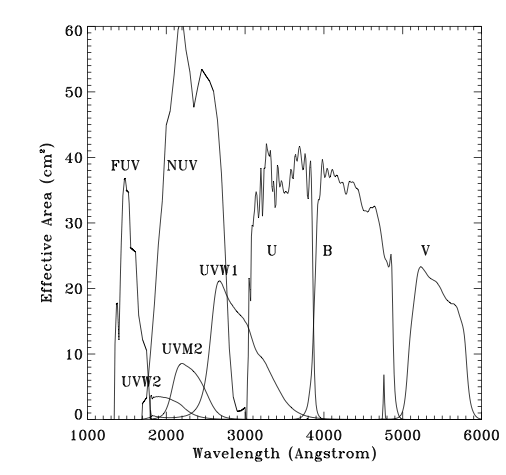|
|||||||||||||||||||
|
|
|||||||||||||||||||
|
|
Brief Description of the OM
This text describing the OM is excerpted from Kuntz et.al. (in prep) with permission of the author.
The telescope and detector:
| Table 2 | |||||
|---|---|---|---|---|---|
| OM Filters | |||||
| Name |  0a 0a(A) |
 maxb maxb(A) |
FWHM (Å) |
PSF FWHM (arcsec) |
Peak Mag. |
| V | 5407 | 5230 | 684 | 1.35 | 19.0 |
| B | 4334 | 3980 | 976 | 1.39 | 19.7 |
| U | 3472 | 3270 | 810 | 1.55 | 19.5 |
| UVW1 | 2905 | 2680 | 620 | 2.0 | 19.3 |
| UVM2 | 2298 | 2210 | 439 | 1.8 | 18.3 |
| UVW2 | 2070 | 2000 | 500 | 1.98 | 17.6 |
| WHITEc | 22.2 | ||||
|
a Effective wavelength b Wavelength of maximum transmission c An "open" filter |
|||||
 |
| Fig.1.-- The two lowest wavelength filters are the GALEX FUV and NUV filters. The next three are the OM UVW2, UVM2, and UVw1 filters. The three highest wavelength filters are the OM U, B, and V filters. |
The observations modes: Due to the onboard centroiding, memory limitations, and telemetry limitations, setting the OM oservations mode has to be a balance of temporal and spatial coverage; the higher the temporal resolution the lower the spatial coverage. As a result, the OM allows a large number of observing modes that place different emphases on temporal and spatial optimization. These modes define different "science windows" covering only portions of the entire FOV; events falling outside of those windows are discarded. There are two primary observations modes at the extremes: the default "imaging" mode and the default "fast" mode.
The default imaging mode consists of five consecutive sub-exposures, each of which employs two science windows; one high-resolution window and one low-resolution window. The high-resolution window (roughly 5' × 5') is always located at the center of the FOV. The five low-resolution windows cumulatively cover the entire FOV (roughly 17' × 17') with a center square surrounded by five rectangular regions. For any number of reasons, not all of the sub-exposures of a default image may actually be taken, but there will always be a high-resolution sub-exposure for each low-resolution sub-exposure. It should also be noted that if multiple filters are used during a single observation, that the area covered by each filter may be different, depending upon the observation mode. The use of five different science windows to cover the FOV, with some overlap between the windows, means that the exposure is not uniform across the FOV. There are two other common full-field low-resolution modes, "ENG-2" and "ENG-4", which are also included in our processing.
The default fast mode uses the same windows as the default imaging mode with the addition of a third science window (roughly 10".5 × 10".5) at an observer defined location (typically the center of the FOV).
The default modes: If the observer did not specify an OM mode, and there was no bright source in the FOV, and the OM was on, the default
imaging mode was used. For the first two years of the mission the default filters were B, UVW2, U, and UVW1, in order of priority.
The filter priority was then changed to UVM2, UVW1, and U, in order to optimize the use of the unique capabilities of the OM.
|
|
|




 Follow Us
Follow Us